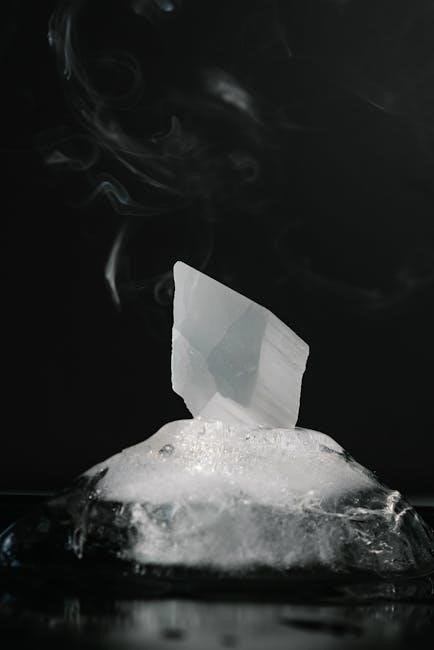Euhomy Ice Maker Self-Cleaning Instructions: A Comprehensive Guide
This guide offers step-by-step instructions for cleaning your Euhomy ice maker, ensuring hygiene and optimal function. Learn to clean removable parts, interior, and hard-to-reach areas. Discover how to use the self-cleaning mode on some Euhomy models for effortless maintenance.
Maintaining a clean ice maker is crucial for producing safe and refreshing ice. This guide focuses on Euhomy ice makers, providing comprehensive cleaning instructions. Euhomy offers various models, including those with a self-cleaning function, making maintenance easier. Regular cleaning prevents the build-up of impurities and ensures optimal performance.
Whether you own a Euhomy nugget ice maker, a pebble ice maker, or a compact countertop model, this guide offers tailored cleaning steps. Euhomy ice makers often feature alerts for low water levels and full ice bins, streamlining operation. However, manual cleaning remains essential for hygiene.
The cleaning process involves removing and washing detachable parts, cleaning the interior with gentle detergents, and rinsing thoroughly. For models with a self-cleaning function, this guide details how to activate and utilize this feature effectively. Alternative cleaning solutions, such as lemon water or diluted vinegar, are also discussed for a natural approach.
By following these instructions, you can maintain a clean and efficient Euhomy ice maker, ensuring a consistent supply of fresh, hygienic ice for your home, office, or bar.
Why Regular Cleaning is Essential
Regular cleaning of your Euhomy ice maker is paramount for several reasons, primarily revolving around hygiene and performance. An unclean ice maker can harbor mold, bacteria, and mineral deposits, contaminating the ice and posing potential health risks. Regular cleaning eliminates these contaminants, ensuring the ice remains safe for consumption.

Beyond hygiene, cleaning directly impacts the ice maker’s efficiency. Mineral build-up from hard water can clog components, reducing ice production and increasing energy consumption. Cleaning removes these deposits, allowing the machine to operate optimally.
Furthermore, regular maintenance extends the lifespan of your Euhomy ice maker. By preventing corrosion and reducing strain on its components, cleaning helps avoid costly repairs and replacements. A clean machine simply works better and lasts longer.

Whether you use your Euhomy ice maker daily or occasionally, a consistent cleaning schedule is vital. Aim for at least weekly cleaning of removable parts and monthly deep cleaning of the interior. For models with self-cleaning functions, utilize this feature regularly to maintain a clean and efficient ice-making process, ensuring your ice is always fresh and safe.
Identifying Your Euhomy Ice Maker Model
Before initiating any cleaning procedure, it is crucial to accurately identify your specific Euhomy ice maker model. Euhomy offers a range of ice maker models, each potentially having slightly different cleaning requirements or features, such as the presence of a self-cleaning function.

The model number is typically located on a sticker or plate affixed to the exterior of the unit. Check the back, bottom, or sides of the ice maker. The label usually includes the model number, serial number, and other manufacturing details.
Once you locate the model number, consult the user manual. The manual provides detailed information on your specific model, including recommended cleaning procedures, compatible cleaning solutions, and instructions for using any self-cleaning features. If you’ve misplaced the physical manual, you can often find a digital version on the Euhomy website by searching for your model number.
Knowing your model ensures you follow the correct cleaning steps and avoid damaging the ice maker. Different models may have different removable parts or require specific cleaning solutions. Using the wrong methods could void your warranty or impair the machine’s performance.
Preparing for the Cleaning Process
Before you begin cleaning your Euhomy ice maker, proper preparation is essential for a safe and effective process. First and foremost, unplug the ice maker from the power outlet. This prevents any electrical hazards during cleaning.
Next, remove all ice from the ice basket or storage bin. Discard any remaining ice to prevent contamination. Then, drain any water remaining in the reservoir. Most Euhomy ice makers have a drain plug or hose located at the back or bottom of the unit. Ensure all water is completely drained.
Gather your cleaning supplies. You will need a soft cloth or sponge, warm water, and a mild detergent or cleaning solution. Some recommended cleaning solutions include diluted vinegar, lemon water, or an ice maker cleaner. Avoid using harsh chemicals or abrasive cleaners, as they can damage the ice maker’s components.
Finally, protect your work area by placing towels or newspapers underneath the ice maker to catch any spills. Ensuring you have everything ready before you start streamlines the cleaning process and minimizes mess.
Cleaning Removable Parts
To thoroughly clean your Euhomy ice maker, start with the removable components. These parts come into direct contact with the ice and water, so it’s crucial to keep them clean. Begin by removing the ice basket or bin. Wash it with warm, soapy water using a soft cloth or sponge. Rinse thoroughly under running water to remove all traces of soap.
Next, remove the ice scoop. Wash it in the same manner as the ice basket, ensuring it is completely clean and free of any residue. If your ice maker has a water filter, remove it and either clean it according to the manufacturer’s instructions or replace it with a new one.
Inspect the water reservoir. If it is removable, take it out and wash it with warm, soapy water. Rinse thoroughly and dry completely before reassembling. For non-removable reservoirs, wipe them down with a damp cloth and mild detergent, then rinse with clean water. Ensure all removable parts are completely dry before placing them back into the ice maker.
Internal Cleaning Procedures
Cleaning the internal components of your Euhomy ice maker is vital for maintaining its performance and ensuring the ice it produces is safe and clean. Start by unplugging the ice maker to ensure safety. Use a soft cloth dampened with a mild detergent solution to wipe down all interior surfaces.
Pay close attention to the ice-making components, such as the evaporator and ice thickness sensor. Gently wipe these parts to remove any mineral buildup or residue. Avoid using abrasive cleaners or scrub brushes, as they can damage these sensitive parts. Rinse the interior thoroughly with clean water to remove any soap residue.
For areas that are difficult to reach, use a cotton swab or a soft brush to clean crevices and corners. If your ice maker has a drain plug, remove it and drain any remaining water. Clean the drain plug and the drain area to prevent clogs. After cleaning, leave the drain plug open to allow the interior to air dry completely before reassembling the ice maker.
Using the Self-Cleaning Function (If Applicable)
Some Euhomy ice maker models come equipped with a self-cleaning function, which simplifies the cleaning process significantly. Before initiating the self-cleaning cycle, consult your ice maker’s user manual to ensure you understand the specific instructions for your model. Generally, you’ll need to empty the water reservoir and add a cleaning solution, such as diluted vinegar or a specialized ice maker cleaner.
Next, locate the “Clean” or “Self-Clean” button on the control panel. Press and hold the button for the recommended duration, often around 5 seconds, to activate the self-cleaning cycle. The ice maker will then automatically run through a cleaning process, which may involve circulating the cleaning solution, washing internal components, and draining the waste water.
Once the cycle is complete, it’s essential to flush the system with fresh water. Refill the reservoir with clean water and run another short cycle to rinse away any remaining cleaning solution. Finally, drain the water and wipe down the interior with a clean cloth. The self-cleaning function makes regular maintenance much easier.
Step-by-Step Self-Cleaning Instructions
To effectively utilize the self-cleaning function of your Euhomy ice maker, follow these step-by-step instructions. First, ensure the ice maker is unplugged from the power source for safety.
- Empty the Reservoir: Remove any remaining water or ice from the water reservoir.
- Prepare Cleaning Solution: Mix a cleaning solution according to the manufacturer’s instructions. A common solution is diluted vinegar or lemon water.
- Add Solution: Pour the cleaning solution into the water reservoir.
- Activate Self-Clean: Plug in the ice maker. Press and hold the “Timer Clean” button (or the designated self-clean button) on the control panel for about 5 seconds to initiate the self-cleaning program.
- Run the Cycle: The ice maker will run an automatic cleaning cycle. This may take approximately 20-30 minutes.
- Rinse Thoroughly: Once the cycle is complete, drain the cleaning solution. Refill the reservoir with fresh water and run another cycle to rinse the system. Repeat this rinsing step at least twice to remove any residual cleaning solution.
- Final Drain: Drain all remaining water from the reservoir.
- Wipe Interior: Wipe down the interior surfaces with a clean, damp cloth.
Your Euhomy ice maker is now clean and ready for use.
Alternative Cleaning Solutions: Lemon Water and Vinegar
While commercial ice maker cleaners are available, lemon water and vinegar offer effective and natural alternatives for cleaning your Euhomy ice maker. These solutions are readily available, affordable, and safe for use in food-related appliances.
Lemon Water: Lemon water is a mild cleaning agent with natural antibacterial properties. The citric acid in lemons helps to dissolve mineral buildup and remove odors. To prepare lemon water, mix equal parts lemon juice and water. For example, use one cup of lemon juice and one cup of water. This solution is gentle and leaves a fresh scent.
Vinegar: White vinegar is a stronger cleaning agent that effectively removes scale, mold, and bacteria. It’s important to dilute vinegar with water to prevent damage to the ice maker’s components. A recommended ratio is one part white vinegar to two parts water. For example, mix one cup of white vinegar with two cups of water.
Using the Solutions: Whether you choose lemon water or vinegar, follow these steps. First, empty the ice maker’s reservoir. Then, pour the chosen cleaning solution into the reservoir. Run the ice maker’s self-cleaning cycle or a regular ice-making cycle, allowing the solution to circulate. After the cycle, drain the solution and rinse the reservoir thoroughly with fresh water, repeating the rinse at least twice to remove any residue. Ensure no lingering scent remains before resuming ice production.
Cleaning Hard-to-Reach Areas

Euhomy ice makers, like many appliances, have areas that are difficult to access during regular cleaning. These spots can accumulate mineral deposits, mold, or bacteria, impacting ice quality and the machine’s performance. Addressing these areas requires patience and the right tools.
Identifying Problem Areas: Common hard-to-reach areas include the water inlet, ice chute, and corners of the reservoir. Use a flashlight to inspect these areas thoroughly. Look for discoloration, buildup, or any signs of residue.
Tools and Techniques: Utilize tools such as cotton swabs, small brushes (like toothbrush), and pipe cleaners to reach narrow spaces. For stubborn deposits, soak a cotton swab in a vinegar or lemon juice solution and gently scrub the affected area. Be careful not to apply excessive force, which could damage delicate components.
Water Inlet: The water inlet can be cleaned using a pipe cleaner dipped in vinegar. Carefully insert the pipe cleaner into the inlet to dislodge any buildup.
Ice Chute: For the ice chute, use a damp cloth wrapped around a thin object, like a spatula or ruler, to wipe down the interior surfaces. Ensure the cloth is not too wet to prevent water from seeping into the machine’s electronics.
Corners of the Reservoir: Use a small brush to scrub the corners of the reservoir, paying attention to any mold or mineral deposits. Rinse thoroughly after cleaning.
Drying and Reassembling the Ice Maker
After cleaning, thoroughly drying and carefully reassembling your Euhomy ice maker is crucial to prevent mold growth and ensure proper functionality. Moisture left inside can lead to bacterial contamination and affect the quality of the ice produced.
Drying Removable Parts: Lay out all removable parts, such as the ice basket and scoop, on a clean, dry surface. Allow them to air dry completely. You can also use a clean, lint-free cloth to pat them dry, ensuring no moisture remains in crevices or corners.
Drying the Interior: Use a clean, dry cloth to wipe down the interior of the ice maker, paying special attention to the water reservoir and ice storage area. Leave the ice maker door open for several hours to allow air to circulate and evaporate any remaining moisture; A fan can be used to expedite the drying process.
Reassembling the Ice Maker: Once all parts are completely dry, carefully reassemble the ice maker. Ensure that all components are properly aligned and securely in place. Refer to your Euhomy ice maker’s user manual for specific reassembly instructions, if needed.
Final Check: Before using the ice maker, double-check that all parts are correctly installed and that there are no loose components. Ensure the drain plug is securely in place to prevent leaks.
Maintenance Tips for Optimal Performance
To ensure your Euhomy ice maker continues to produce clean, refreshing ice and operates efficiently, regular maintenance is essential. Following these tips will help prolong its lifespan and prevent potential issues.
Regular Cleaning Schedule: Establish a consistent cleaning schedule, ideally cleaning the ice maker at least once a week or more frequently if you notice any buildup or discoloration. Regular cleaning prevents the accumulation of mold, bacteria, and mineral deposits that can affect ice quality and machine performance.
Water Quality: Use filtered water whenever possible to minimize mineral buildup in the ice maker. Hard water can lead to scale formation, which can reduce efficiency and damage internal components.
Proper Ventilation: Ensure the ice maker has adequate ventilation to prevent overheating. Do not block the vents on the sides or back of the unit. Good airflow helps the ice maker maintain optimal operating temperature.
Emptying the Ice Storage: Periodically empty the ice storage bin, even if the ice is not fully used. This prevents ice from clumping together and becoming stale. It also allows you to inspect the bin for any signs of mold or buildup.
Descaling: Depending on your water quality, you may need to descale the ice maker periodically to remove mineral deposits. Use a descaling solution specifically designed for ice makers, following the manufacturer’s instructions.
Troubleshooting Common Cleaning Issues
Even with careful cleaning, you might encounter some issues while maintaining your Euhomy ice maker. Here are some common problems and how to address them:
Persistent Odors: If unpleasant odors linger after cleaning, try using a solution of lemon water or vinegar and running a self-cleaning cycle. Ensure all parts are thoroughly rinsed after cleaning to remove any residual cleaning agents.
Scale Buildup: Hard water can cause stubborn scale buildup. Use a descaling solution specifically designed for ice makers. You may need to repeat the descaling process several times to remove all deposits.
Mold or Mildew: If you spot mold or mildew, clean the affected areas with a mixture of water and bleach (a very diluted solution). Rinse thoroughly and allow the parts to air dry completely before reassembling. Ensure proper ventilation to prevent future growth.
Clogged Water Lines: Mineral deposits or debris can clog water lines. Try flushing the lines with vinegar or a descaling solution. If the clog persists, you may need to disassemble the lines and manually clean them.
Self-Cleaning Cycle Issues: If the self-cleaning cycle doesn’t seem to be working correctly, ensure that the water reservoir is filled to the appropriate level and that the cleaning agent is properly diluted. Check the user manual for specific instructions and troubleshooting tips.
